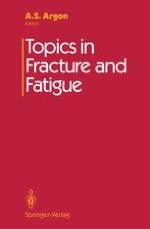Fracture in structural materials remains a vital consideration in engineering systems, affecting the reliability of machines throughout their lives. Impressive advances in both the theoretical understanding of fracture mechanisms and practical developments that offer possibilities of control have re-shaped the subject over the past four decades. The contributors to this volume, including some of the most prominent researchers in the field, give their long-range perspectives of the research on the fracture of solids and its achievements. The subjects covered in this volume include: statistics of brittle fracture, transition of fracture from brittle to ductile, mechanics and mechanisms of ductile separation of heterogenous solids, the crack tip environment in ductile fracture, and mechanisms and mechanics of fatigue. Materials considered range from the usual structural solids to composites. The chapters include both theoretical points of view and discussions of key experiments. Contributors include: from MIT, A.S. Argon, D.M. Parks; from Cambridge, M.F. Ashby; from U.C. Santa Barbara, A.G. Evans, R. McMeeking; from Glasgow, J. Hancock; from Harvard, J.W. Hutchinson, J.R. Rice; from Sheffield, K.J. Miller; from Brown, A. Needleman; from the Ecole des Mines, A. Pineau; from U.C. Berkeley, R. O. Ritchie; and from Copenhagen, V. Tvergaard.
